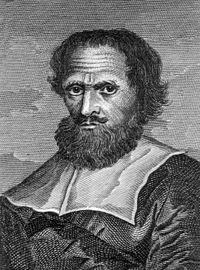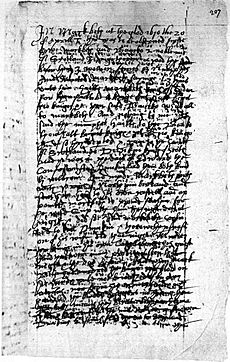Simon Forman facts for kids
Quick facts for kids
Simon Forman
|
|
|---|---|
 |
|
| Born | 31 December 1552 Quidhampton, Wiltshire, England
|
| Died | 5 or 12 September 1611 |
| Resting place | St Mary, Lambeth |
| Nationality | English |
| Education | Salisbury grammar school |
| Alma mater | Magdalen College, Oxford |
| Occupation | astrologer alchemist medical practitioner |
| Known for | Extensive records of astrological practice, Eye-witness accounts of plays by William Shakespeare Alleged complicity in murder of Sir Thomas Overbury |
| Spouse(s) | Jean Baker |
Simon Forman (born December 31, 1552 – died September 5 or 12, 1611) was a fascinating person from the time of Queen Elizabeth I and King James I of England. He lived in London and was known as an astrologer, someone who studied the stars to predict the future. He was also an occultist, meaning he was interested in magic and hidden knowledge, and a herbalist, someone who used plants for medicine.
After he died, his reputation was damaged because he was linked to a plot to harm Sir Thomas Overbury. Even so, other astrologers continued to respect him. However, writers like Ben Jonson and Nathaniel Hawthorne often wrote about him as either a silly person or a powerful, evil magician.
Contents
Simon Forman's Life Story
Early Years and Learning
Simon Forman was born in a place called Quidhampton, near Salisbury, Wiltshire, England. This was on December 31, 1552. When he was nine, he started going to a free school in the Salisbury area.
Sadly, his father died exactly two years later, on December 31, 1563. This meant Simon had to leave school. For the next ten years, he worked as an apprentice for a local merchant named Matthew Commin.
Commin sold cloth, salt, and herbal medicines. During this time, Simon began to learn a lot about using plants for remedies. After some disagreements with Mrs. Commin, Simon's apprenticeship ended. He then went to study at Oxford as a poor student. He spent about a year and a half at Magdalen College, where he likely became very interested in medicine and astrology.
Becoming a Physician and Astrologer
Throughout the 1570s and 1580s, Forman worked as a teacher. At the same time, he was deeply studying the occult arts, which are about hidden or secret knowledge. In the early 1590s, he moved to London. There, he started his own practice as a physician in a place called Philpot Lane.
In 1592, he survived a serious outbreak of the plague. After this, his reputation as a doctor began to grow. In 1597, a clergyman named Richard Napier became his student. Forman became even more interested in the occult in the 1590s. He built a very successful practice as an astrologer and physician.
He kept detailed records, called casebooks, of his clients' questions. People asked him about illnesses, pregnancy, lost items, job chances, and marriage. His success and methods caught the attention of the College of Physicians. They tried to stop him from practicing medicine. However, he eventually got a special license to practice from the University of Cambridge in 1603.
Predicting His Own Death
In 1611, Simon Forman made a very accurate prediction about his own death. He said he would die on the River Thames. Another astrologer, William Lilly, wrote about it.
Lilly said that one warm Sunday in September, Forman told his wife he would die the following Thursday night, which was September 12. His wife teased him about it because he seemed perfectly fine on Monday, Tuesday, and Wednesday.
On Thursday, after dinner, Forman was still well. He went to the riverside and took a boat to go to some buildings he was working on. While in the middle of the Thames, he suddenly fell down. He only said, "An impost, an impost," and then he died. A big storm followed right after.
A Tarnished Reputation
Five years after Simon Forman died, his name was connected to the death of Thomas Overbury. This happened when two of Forman's former patients, Lady Frances Howard and Mrs Anne Turner, were found guilty of the crime.
During Lady Howard's trial, lawyers accused Forman of giving her a special potion. They claimed she used this potion in her plan to harm Overbury. The Lord Chief Justice, Sir Edward Coke, even called him "Devil Forman" during the trial. Because of these accusations, Simon Forman's reputation was severely damaged.
Simon Forman's Writings
A Treasure Trove of Information
Simon Forman's many papers have been incredibly valuable to historians. They offer rare and unusual details about a very important time in history. His writings include stories about his own life, guides to astrology, and notes about the plague. He also kept commonplace books about alchemy, which was an old form of chemistry. He wrote notes on the Bible and historical events too.
His papers also show his disagreements with the College of Physicians. They even contain details about his magical experiments, which were mostly unsuccessful. At one point, he owned a copy of an important book called the Picatrix. Forman left behind many handwritten documents. These covered all the subjects he was interested in, from astronomy and astrology to medicine, mathematics, and magic.
His Casebooks are the most famous of these writings. Like his diaries and autobiographies, they contain many details about his life. The only thing he ever had printed was a small pamphlet. It advertised a fake way to figure out a ship's location at sea.
Connections to Shakespeare
Forman knew many people in William Shakespeare's group of friends and colleagues. This makes his writings very interesting to people who study literature. Modern scholars, like A. L. Rowse, have used Forman's papers. They help us learn about the private lives of men and women during the Elizabethan and Jacobean times.
One of Forman's patients was the poet Emilia Lanier. Some people think she might have been Shakespeare's "Dark Lady" from his sonnets. Another patient was Mrs Mountjoy, who was Shakespeare's landlady.
Sixty-four volumes of Forman's handwritten papers were collected by Elias Ashmole in the 1600s. These are now kept at the Bodleian Library in Oxford. A team led by Professor Lauren Kassell from the University of Cambridge has made digital copies of his records.
The "Book of Plays"

Among Simon Forman's many papers is a section called the "Bocke of Plaies." This part describes four plays he watched between 1610 and 1611. He also wrote down the lessons he learned from them.
This document is very important because it lists three performances of plays by Shakespeare:
- Macbeth at the Globe Theatre on April 20, 1610.
- The Winter's Tale at the Globe on May 15, 1611.
- Cymbeline, though the date and theater are not mentioned.
The fourth play Forman described was a Richard II performed at the Globe on April 30, 1611. However, from his description, it is clear this was not Shakespeare's Richard II.
The "Bocke of Plaies" manuscript was first described by John Payne Collier in 1836. In the 1900s, some people thought it might be one of his forgeries, meaning he might have faked it. But today, most scholars believe this section is real, though a few still have doubts.

